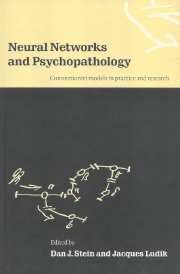Book contents
- Frontmatter
- Contents
- List of contributors
- Preface
- Part one General Concepts
- 1 Neural networks and psychopathology: an introduction
- 2 The history of neural network research in psychopathology
- 3 Neural network models in psychiatric diagnosis and symptom recognition
- 4 Neural networks and psychopharmacology
- 5 A connectionist view of psychotherapy
- 6 Modulatory mechanisms in mental disorders
- Part two Clinical disorders
- Epilogue
- Index
3 - Neural network models in psychiatric diagnosis and symptom recognition
from Part one - General Concepts
Published online by Cambridge University Press: 12 January 2010
- Frontmatter
- Contents
- List of contributors
- Preface
- Part one General Concepts
- 1 Neural networks and psychopathology: an introduction
- 2 The history of neural network research in psychopathology
- 3 Neural network models in psychiatric diagnosis and symptom recognition
- 4 Neural networks and psychopharmacology
- 5 A connectionist view of psychotherapy
- 6 Modulatory mechanisms in mental disorders
- Part two Clinical disorders
- Epilogue
- Index
Summary
Matters historical
Psychiatric diagnosis has been conceptualized as either a ‘one-off’ (‘recognition’) type of cognitive act or as a ‘recursive (constructional) process’. History teaches us that scientists choose their models not on the basis of some ‘crucial empirical test’ (such tests do not exist at this level of abstraction) but on the more humdrum (but rarely owned up to) dictate of fashion. For example, during the eighteenth century, when the so-called ‘ontological’ notions of disease (as it was then based on the more botanico tradition) (Berg, 1956; López-Piñero, 1983), reigned supreme, there was little problem in accepting the view that the diagnosis (recognition) of disease happened at one fell (cognitive) swoop. This was because the Platonic (ontological) assumption lurking behind such a notion amply justified the belief that disease was ‘fully bounded and out there’ and, furthermore, that inklings of its existence had been planted at birth (like everything else) in the mind of the diagnostician. The a priori privileging of some features of a disease (the successful strategy that Linné had already tried on plants), and the view that such features actually ‘signified’ the disease, was just one version of the ontological approach. Indeed, a century earlier, a similar view had governed the study of linguistics (Aarsleff, 1982). That it was fashion and Zeitgeist that sustained the popularity of the ontological view is illustrated by the fact that a rival approach put forward at the time by Adanson was given short shrift (Stevens, 1984).
- Type
- Chapter
- Information
- Neural Networks and PsychopathologyConnectionist Models in Practice and Research, pp. 34 - 56Publisher: Cambridge University PressPrint publication year: 1998
- 1
- Cited by



